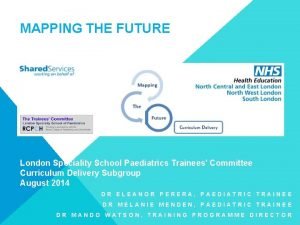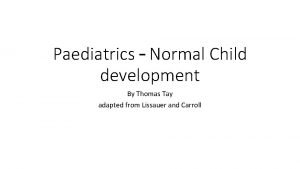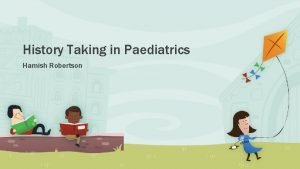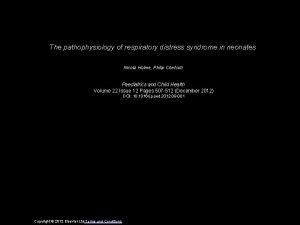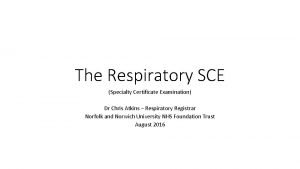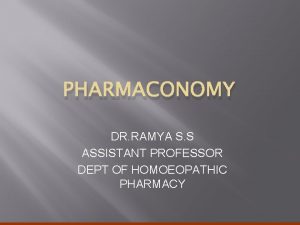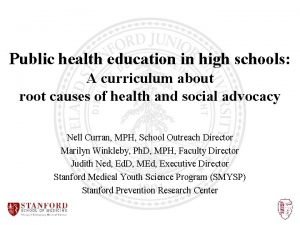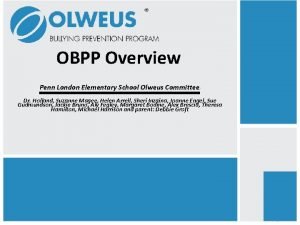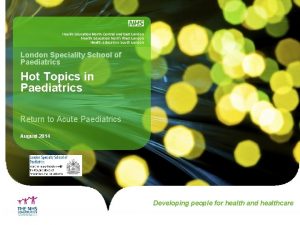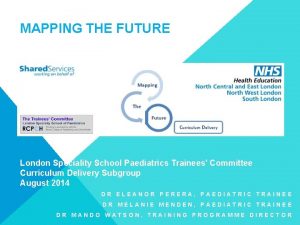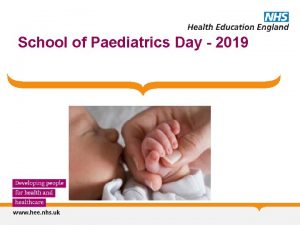London Speciality School of Paediatrics Hot Topics in



























- Slides: 27

London Speciality School of Paediatrics Hot Topics in Paediatrics Return to Acute Paediatrics August 2014 Developing people for health and healthcare

Aims • To reassure you that not much has changed • To give you some gems so you can sound knowledgeable from the first ward round • To update you on what’s been happening in paediatrics as a speciality • To signpost some resources Developing people for health and healthcare

Topics • Feverish child and NICE guidance • Head injury in children • Optiflow • Rotavirus Vaccine • Haemoglobin/Codeine and Domperidone • Frances Report • ‘Back to facing the future’ Developing people for health and healthcare

FEVERISH ILLNESS IN CHILDREN Developing people for health and healthcare

NICE Guideline “Feverish illness in children” Provides a tool to risk assess feverish children for serious bacterial illness, Traffic light system An adequate ‘safety net’ a) providing the parent or carer with verbal and/or written advice on warning symptoms and how further care can be accessed or b) the parent or carer is given follow up at a specific time and place or c) ensuring direct access for the patient if further assessment is required. Standards 1. Children presenting to Emergency Departments (EDs) with medical conditions should have respiratory rate, oxygen saturation, pulse, blood pressure/capillary refill, GCS/AVPU and temperature measured and recorded as part of the routine assessment 2. Discharged children in whom no diagnosis is found and with amber features, should be provided with an appropriate ‘safety net’ 3. 90% of children with amber features and without an apparent source of infection should not be prescribed antibiotics 4. Children with fever and without an apparent source of infection but with one or more red features should have FBC, CRP, blood culture and urinalysis performed 5. EDs should have written advice to give to the carer/s of discharged children 6. EDs should have access to the NICE guideline Traffic Light System Developing people for health and healthcare

Traffic Light system for identifying risk of serious illness (new 2013) children with fever and any of symptoms or signs in red colum should be recognised as being at high risk Developing people for health and healthcare

Measurement of body temperature at other sites In infants under the age of 4 weeks: Electronic thermometer in the axilla In children aged 4 weeks to 5 years: Electronic thermometer in the axilla Chemical dot thermometer in the axilla Infra-red tympanic thermometer • Subjective detection of fever by parents and carers • Reported parental perception of a fever should be considered valid and taken seriously by healthcare professionals Developing people for health and healthcare

NICE GUIDELINES FOR HEAD INJURY Developing people for health and healthcare

Head Injury in Children CT < 1 hr • NAI • Post traumatic seizures • GCS < 14/ GCS < 15 (under 1) on presentation to ED • 2 hours after injury – GCS <15 • Suspected open/depressed skull fracture/ open fontanelle • Signs of basal skull fracture • Focal deficit • < 1 year –bruise/ swelling/ laceration >5 cm Developing people for health and healthcare CT vs obs >1 following risk factors (perform CT in 1 hour of finding RF • LOC > 5 minutes • Abnormal drowsiness • 3 or more discrete episodes of vomiting • Dangerous mechanism • Amnesia > 5 minutes Only 1 RF – observe for 4 hours

OPTIFLOW Developing people for health and healthcare

Optiflow What is Optiflow? • System required to deliver humidified high flow oxygen therapy via a nasal cannulae • The system comprises of a Max. Venturi and a Fisher & Paykel MR 850 humidifier What kind of treatment does it offer? • Humidified High Flow Nasal Cannula (HHFNC) therapy • Increasingly utilised modality for the management of patients with Type 1 respiratory failure • Constitutes delivery of high inspiratory gas flow (up to 50 L/min), warmed to body temperature, pressure saturated for optimal humidification and accurately titrated oxygen content (32 – 100%) Developing people for health and healthcare

Optiflow What are the benefits? 1. Reversal of hypoxaemia 2. Reduce work of breathing 3. Improved secretion clearance 4. Avoidance of intubation 5. Improved patient tolerance and comfort 6, Unhindered speaking/ feeding What are the indications? 1, Patients with hypoxaemic Type I respiratory failure 2. Patients with increased work of breathing 3. Poor compliance of mask therapy where O 2 requirements are > 4 l/min 4. Increased secretion viscocity with an impaired ability to clear secretions Developing people for health and healthcare

Optiflow What are the contraindications? 1. Patients at risk of type II (hypercapnic Respiratory failure) secondary to O 2 delivery 2. Basal skull fractures 3. CSF leak 4. Nasal passage abnormalities or recent nasal surgery 5. Respiratory arrest/ peri-arrest 6. Platelets < 85 (or severe epistaxis) How do you chose your flow? 2 L/kg/min up to 10 Kg Plus 0. 5 L/kg/min > 10 Kg Developing people for health and healthcare

ROTAVIRUS VACCINE Developing people for health and healthcare

Rotavirus Vaccine (Rotarix) • Over 85% effective at preventing severe rotavirus gastroenteritis in first two years of life • Live vaccine given orally at two and three months • Can only given if over 6 weeks and first dose before 15 weeks of age • Course must be completed by 24 weeks of age • Contraindications; • Previous intussusception and GI malformation leading to intussusception • SCID • Rare hereditary problems of fructose intolerance, glucose/galactose malabsorption or sucrose- isomaltase insufficiency • Small risk of intussusception post first dose: MUST WARN PARENTS • Risk of transmission through stool therefore strict hand hygiene Developing people for health and healthcare

Codeine / Haemoglobin and Domperidone Developing people for health and healthcare

Codeine / Haemoglobin and Domperidone Codeine Phosphate: Statement from RCPCH 2013 Following a review of the literature and analysis of several deaths outside hospital the advice given by the MRHA codeine should not be used in any child with: • A history of sleep apnoea who is undergoing tonsillectomy or adenoidectomy • Codeine should only be used in children over the age of 12 years. Understanding that codeine is variably metabolised to morphine and that some children (fast metabolisers) will be vulnerable to unpredictable and excessive respiratory depression Developing people for health and healthcare

Codeine / Haemoglobin and Domperidone Haemoglobin: From 2013, all haemoglobin (Hb) and mean cell haemoglobin (MCHC) results from the haematology laboratories are now reported in g/L This means a Hb concentration value previously expressed as 10. 8 g/dl will now be expressed as 108 g/L Follows recommendations from The National Pathology Harmony Committee, an initiative sponsored by the Department of Health, that reporting units of haemoglobin (Hb) and mean cell haemoglobin (MCHC) should be changed from g/d. L to g/L Any diagnostic or treatment algorithms that are based on haemoglobin concentration will need to be altered to accommodate this change Developing people for health and healthcare

Codeine / Haemoglobin and Domperidone: • Domperidone is associated with a small increased risk of serious cardiac side effects. • Its use is now restricted to the relief of symptoms of nausea and vomiting • Dosage and duration of use have been reduced. • Now contraindicated in those with underlying cardiac conditions and other risk factors such as hepatic failure • In children under 12 years of age and weighing less than 35 kg, the recommended maximum dose in 24 hours is 0. 75 mg/kg body weight (dose interval: 0. 25 mg/kg body weight up to three times a day) • The maximum treatment duration should not exceed one week • Patients currently receiving long-term treatment should be reassessed at a routine appointment to advise on treatment continuation, dose change, or cessation Developing people for health and healthcare

Frances Report Developing people for health and healthcare

Frances Report • Enquiry into the Mid Staffordshire NHS Foundation Trust • Enquiry of care provided between 2005 - 2008 • The Inquiry Chairman, Robert Francis QC, concluded that patients were routinely neglected by a Trust that was preoccupied with cost cutting, targets and processes and which lost sight of its fundamental responsibility to provide safe care • July 2009 the Secretary of State for Health ordered another independent enquiry and the report was made available in February 2013 Developing people for health and healthcare

Frances Report • The report was published on 6 February 2013 and makes 290 recommendations, including: • openness, transparency and candour throughout the healthcare system (including a statutory duty of candour), fundamental standards for healthcare providers • improved support for compassionate caring and committed nursing and stronger healthcare leadership Developing people for health and healthcare

Frances Report - References Executive summary of the Francis report http: //www. midstaffspublicinquiry. com/sites/default/files/repor t/Executive%20 summary. pdf RCPCH response to the Enquiry http: //www. rcpch. ac. uk/news/rcpch-responds-francis-inquiry Developing people for health and healthcare

BACK TO FACING THE FUTURE Developing people for health and healthcare

Back to facing the future • Facing the Future: a review of paediatric acute services (April 2011) • 10 standards for acute paediatric services • Back to facing the future • commitment of the RCPCH to audit the standards Developing people for health and healthcare

Back to facing the future Report in April 2013: • 77% of children seen by a senior in the first 4 hours • 88% of children seen by a senior in the first 24 hours • Discrepancy of care in the day and evening with only 6% of consultants being present at peak times in the weekend • Shortfall of staff http: //www. rcpch. ac. uk/system/files/protected/page/Facing% 20 the%20 Future%20 -%20 exec%20 summary. pdf Developing people for health and healthcare

Summary • Not that much has changed! • Even the papers that have had the highest impact haven’t actually changed practice much • Clinical experience counts more than anything • Lots happening at an organisational level… don’t panic Developing people for health and healthcare
 London school of paediatrics
London school of paediatrics Polysyllabic babble
Polysyllabic babble History taking paediatrics
History taking paediatrics Paed
Paed Neonatology lectures
Neonatology lectures Speciality certificate examination in respiratory medicine
Speciality certificate examination in respiratory medicine Uraikan ruang lingkup dari layout toko
Uraikan ruang lingkup dari layout toko Layout supermarket
Layout supermarket Signet gifted education program
Signet gifted education program My future profession programmer
My future profession programmer Pharmaconomy in homoeopathy
Pharmaconomy in homoeopathy How to pass fcps part 1 in first attempt
How to pass fcps part 1 in first attempt Hot topics in sports nutrition
Hot topics in sports nutrition Hot topics in patent law
Hot topics in patent law Hot topics in networking
Hot topics in networking Hot topics in leadership
Hot topics in leadership Travel histology jobs
Travel histology jobs Hot topics in networking
Hot topics in networking White hot vs red hot temperature
White hot vs red hot temperature Cold working advantages
Cold working advantages Perbedaan hot lava dan hot lava volcano
Perbedaan hot lava dan hot lava volcano Be either hot or cold
Be either hot or cold Magazine article introduction example
Magazine article introduction example Interesting sabbath school topics
Interesting sabbath school topics Sabbath school classes names
Sabbath school classes names Health education topics for primary school students
Health education topics for primary school students Kings college london maths school
Kings college london maths school Penn london elementary
Penn london elementary
